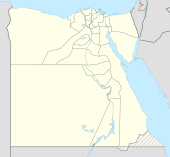Sarabit al-Chadim
Sarabit al-Chadim ( Arabic سرابيط الخادم, DMG Sarābīṭ al-Ḫādim ) is an archaeological site on the Sinai Peninsula .
The place is halfway up the west coast in southwest Sinai, about 10 km north of Wadi Maghara . It is one of the most important regions of ancient Egyptian settlements on the Sinai Peninsula and mainly served as a mining site for copper and turquoise . Above all, the goddess Hathor was worshiped as the "mistress of turquoise" and Sopdu as the "lord of the eastern desert".
history
Egyptian influences in Sinai have already been proven in the early dynastic epoch. The peninsula was searched for mineral resources from the Old to the New Kingdom .
Temple complex
In Serabit al-Chadim there is an unusual temple complex of shrines and sanctuaries , which was primarily dedicated to Hathor, the patron goddess of the workers in the copper and turquoise mines. The temple is not axially symmetrical , as usual , but had to be adapted to local conditions. Rather, it is an irregular quadrangle around 100 m long, bordered by a ring wall made of quarry stone .
The main entrance was on the narrow western side and was flanked by steles of Ramses II and Sethnacht . In a west-east direction up to the inner courtyard there were fourteen pillar rooms , built up from cut blocks , which were built between the 18th and 20th dynasties . The larger inner courtyard probably originates from the Middle Kingdom . In the innermost corner were the cult grottoes of Hathor and Sopdu, those of Amenemhet III. and Amenemhet IV. were laid out next to each other in the southeast corner of the courtyard and are among the oldest rock temples in Egypt.
Finds
The most important finds include steles and inscriptions that provide information about expedition activities.
In addition, were in thick layers broken alabaster - and faience - Votive , as well as numerous royal and private sculpture found stelae and victims stand up to the time of King Sneferu rich. In the vestibules of the sanctuaries there were pools of water that indicate religious ablutions . In addition, thick layers of coniferous ash were found under the sanctuary of the New Kingdom , which indicate intense incense and cult customs of the neighboring Canaan .
literature
- Dieter Arnold : Lexicon of Egyptian architecture. Albatros, Düsseldorf 2000, ISBN 3491960010 , pp. 233-234 (→ Serabit el-Chadim).
- Dieter Arnold: The temples of Egypt. Artemis & Winkler, 1992, ISBN 376081073X , pp. 222-224.
- Richard H. Wilkinson : The world of temples in ancient Egypt. Theiss, Stuttgart 2005, ISBN 3-8062-1975-3 , p. 239.
Web links
Individual evidence
- ↑ a b Wilkinson: The world of temples in ancient Egypt , 2000, pp. 238-239.
- ^ A b Arnold: Lexikon der ägyptischen Baukunst , 2000, pp. 233-234.
- ↑ Arnold: Die Tempel Ägyptens , 1996, pp. 222–224.
Coordinates: 29 ° 2 ′ 12 ″ N , 33 ° 27 ′ 33 ″ E

